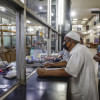Cheap clothes at cost of life

"Low prices. Every Day. On everything" -- Wal-Mart's new slogan replaces the old one in circulation since 2007 -- "Save money. Live better". Both show the sad face of garment business. They also reveal the crux of the problem: when you want to go cheap, your operation will go cheap too. You have to get the cheapest thing from the garment manufacturer. And the manufacturer will try to cut corners.
The big question is: which corner will he cut? If one looks at the value chain of garment manufacturing, the answer becomes clear. The lone objective of the international buyers is to negotiate orders at the same price, if not less, as last year's. And, for every year, it is always a done deal as an unofficial league of big buyers maintains an identical low price policy in negotiation.
In the whole string of operations, the job of manufacturers is to bring in fabrics and accessories and then make clothes that involve around 20 percent of the negotiated price.
The big international buyers control the remaining 80 percent for, at least, not to sell clothes at a lower price. The sale price is usually 4-8 times the purchase price. So, the manufacturer is left with 20 percent, with which salary of workers and other overhead costs are taken care of.
The garment maker in Bangladesh has no idea if the supplier is providing the fabrics and accessories at a competitive price and with reasonable quality. The buyers control the fabrics or accessories on the pretext of quality control.
The big buyers, in most cases, designate suppliers of their choice. It is also commonly found that the suppliers of fabrics and accessories are often sister concerns of the buyers. If that is the case, then it is only logical to think that the buyers will not put their own sister organisations through the rigour to get the best price. Instead what they do is lemon-squeeze the manufacturers.
They scoop the cream off from suppliers to the manufacturer and then go on to offer less and less rates for cutting and sewing.
Let's take the case of Tanvir Jewel, who runs a knit factory in Savar for close to a decade. He is making Polo shirts at almost the same price he used to make 10 years back. The overhead costs including workers' wage have gone double in the last 5 years but not the prices in orders.
"Prices we get are far from reality. I try mainly now to increase production rate further to find a solution to the mismatch in prices," says Jewel.
That means workers eventually bear the brunt of buyers' cheap clothes venture. Interestingly though, a few small buyers have still kept him in the business. Small buyers are yet to master the art of making money out of suppliers and manufacturers. But that's not the case with all manufacturers.
As rates tumble, the manufacturer looks at his variable costs mainly wages and production facility rent because he has no control over fixed costs.
He starts paying less and less to his labourers -- a reason why garment wages rise so slowly in Bangladesh. And then he searches for the cheapest manufacturing facilities.
He tries to maximise the space disregarding compliance issues like fire safety and building safety.
These together then make for the deadly concoction of labour unrest, building collapse and deaths in fire. Tazreen, Spectrum and Rana Plaza are born and repeated over and over.
Leading non-profit advocacy organisation, the International Labour Rights Forum in its document -- Deadly Secrets -- shed light on the greed merchants. The relationship between poor purchasing practices and dangerous working conditions is not rocket science, it observes.
The World Bank too notes that the "price and compliance decisions of buyers are not synchronised."
Angry at the apparent nonchalance of world's top buyers, the Clean Clothes Campaign has accused them of criminal negligence.
For cheap price, these brands choose factories that are virtual death traps.
On paper, the buyers may do a lot of tall talks. Take Primark as an example. The garment factories inside Rana Plaza that collapsed in Savar leaving 381 people dead were making products for Primark, a UK-based company.
Let's check what its website says about ethical business. "Primark works closely with the suppliers and factories that produce its goods. It provides training for suppliers, factories and its own buyers so that they understand ethical issues. "The role of Primark buyers is important in helping to support ethical business practices. When selecting new suppliers and factories, Primark requires them to go through a selection process.
This enables Primark to establish if working conditions are appropriate or if improvements are necessary before the supplier can be approved." And then it says Primark's code of conduct states that within its supply chain working conditions are safe and hygienic.
The Savar tragedy only shows how empty these promises are for end customers. It certainly shows little care about the factory set-up and the working conditions where the workers are coerced into joining work.
Global opinion is almost similar: the buyers should do more to ensure work place safety. The labour organisations and NGOs have long been pressing them to agree on a uniform fire-free safety formula. The formula is agreeable but not the proposal that binds buyers to fork out money on the programme. Money prevailed over life.

 For all latest news, follow The Daily Star's Google News channel.
For all latest news, follow The Daily Star's Google News channel. 








Comments